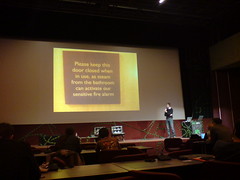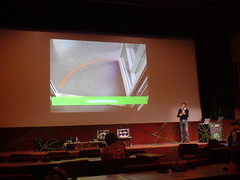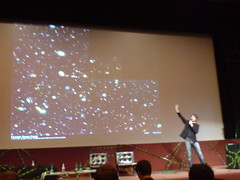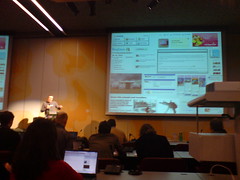LIFT07: Embracing the real world's messiness, Fabien Girardin
February 09, 2007 | CommentsLIFT07: Embracing the real world's messiness, Fabien Girardin
He's an engineer/researcher into ubicomp and HCI. What's the reality of the integration of tech into our everyday life?
 Shows a sign asking room residents to shut a bathroom when having a shower, to avoid setting off a fire alarm. The vision of ubicomp is to be "seamless", invisible, and calm. Seamless access to ambient connectivity isn't here (err what about GSM) and may never be.
Shows a sign asking room residents to shut a bathroom when having a shower, to avoid setting off a fire alarm. The vision of ubicomp is to be "seamless", invisible, and calm. Seamless access to ambient connectivity isn't here (err what about GSM) and may never be.
Automatic doors have sensors in various places: foot, top of door, etc. Watch people interact with them: the doors usually don't react the way people want. People wave their hands at the top of the door to activate the sensor: imperfect interactions with the door, in a controlled environment today. Despite the money spent, the company implementing this has failed to give people what they want.
The world is messy. Infrastructures which we rely on need to be maintained: they break down. Heterogeneity: we have agreed standards but they don't necessarily interop, look at remote controls. Technologies co-exist: we're building a Babel-like tower of technologies which collaborate and compete.
Who owns ubicomp resources? Even if the facilities (e.g. power) are there, that doesn't mean we have permission to use them. Look at power sockets on trains in the UK, for instance.
There's cultural bias. Fabien hasn't worked out how to use UK taps to mix hot and cold water. We're unpredictable: how do we develop context-aware ambient intelligence to deeply get into our own behaviour?
 "Seamful design" seeks to reveal the limits, boundaries and uncertainties of ubicomp: reveals the seams. Shows a game which displays the uncertainties of LBS on a small screen. Shows a sign in Barcelona which tells you there's a CCTV camera in the location, and also how far its coverage extends: so you know where the surveilled area is. Shows an automatic door which has a mark on the floor showing its radius, so users can tell where it will open to.
"Seamful design" seeks to reveal the limits, boundaries and uncertainties of ubicomp: reveals the seams. Shows a game which displays the uncertainties of LBS on a small screen. Shows a sign in Barcelona which tells you there's a CCTV camera in the location, and also how far its coverage extends: so you know where the surveilled area is. Shows an automatic door which has a mark on the floor showing its radius, so users can tell where it will open to.
Co-existence with technologies is about accommodation and appropriation. Technologies need to be customisable, not just graceful.
Seamlessness is the exception: messiness can't be ignored, we need to design technologies with this in mind. Do we really want to live in a calm world?
A fantastic talk, I wish he could have spoken for longer.
LIFT07: CERN's 27km Big Bang machine, Brian Cox
February 09, 2007 | Comments LIFT07: CERN's 27km Big Bang machine, Brian Cox
LIFT07: CERN's 27km Big Bang machine, Brian Cox
Half the particle physicists in the world are connected to CERN.
We're trying to understand the basic building blocks of the universe.
"All science is either physics or stamp collecting" - Ernest Rutherford (who went on to win a Nobel Prize for chemistry).
"We are the little difference in behaviour between matter and anti-matter"
Things that have weight do so because their particles are surrounded by Higgs particles.
Dataflow : 10k encyclopedia britannicas;/second generated by the Hadron Collider.
95% of the universe is made up out of stuff that isn't our matter. 25% dark matter.
Show's a video of two galaxies colliding together. The dark matter just passes on, the normal matter collides and bangs into itself.
"We can see 11 dimensions by making mini-black holes in the Hadron Collider. Which is not dangerous, honest."
"The Higgs is a theory. We got the money on the basis that we'd find it. If we don't we'll have to run away."
My notes for this one are poor because I've spent most of the talk with my mouth open, jaw on desk.
LIFT07: Blowing the web apart, Ivan Pope
February 09, 2007 | CommentsLIFT07: Blowing the web apart, Ivan Pope
Giving a "User-Generated Talk". The talk is a "widget embedded into the conference". Was an artist, entrepreneur and anarchist. "I've never blown up anything".
Widgets are everything that goes between the HTML tags. "I'm not a coder or designer, so this is a bit obscure to me". Everything there is a fragment of content, assembled by the makers.
Interested in how you fragment every piece of content, take every item down to its smallest part. Let consumers decide how it can be used. Every component of web pages should be widgetised so it can "reassemble itself". "Pick up the fragments and recomposite them into something similar to what you started with".
 You can see people mucking around already, on sites like MySpace, on weblogs or on start pages like Netvibes. Blog software and social networks stop you from doing what you want here.
You can see people mucking around already, on sites like MySpace, on weblogs or on start pages like Netvibes. Blog software and social networks stop you from doing what you want here.
Moderator: there's a movement in SF of trying to widgetise the web, driven from San Francisco: microformats.
Q: The idea of widgets sounds great, but how does this affect advertising? What happens if end-users just aggregate widgets from different sites?
IP: We need to work out the answer to that question. Working out biz models for individual widget companies isn't the point. Advertising, possible. Content owners need to attach monetisation opportunity to their content as it goes out. I want a world where I don't put my stuff into my blog, I want to put my blog into my stuff (?). Blogs should be a set of widgets, dropped into a container.
Q: This is an interesting idea, a transition from page paradigm of the web to a flow paradigm.
IP: It's backwards and forwards, it's a swirl.
(The backchannel degenerates into a discussion on blowing midgets apart)
Hume's Assertion
February 09, 2007 | CommentsAny theory around technology or its use which contains the words "always" or "never" is probably balls.
links for 2007-02-08
February 08, 2007 | Comments-
Kinda anti-multiple window software. Blanks out everything else in a pleasing fashion.
-
"It is possible that this new consortium will do a deal with Google, Yahoo!, or similar to share advertising revenue, but the real question is if the network operators are arrogant enough to think they can do better - and the answer is they probably are."
-
Nokia launched its DIY firmware upgrade service in August last year, and while many users have benefited from ready-to-install upgrades, the service has been plagued by bugs.